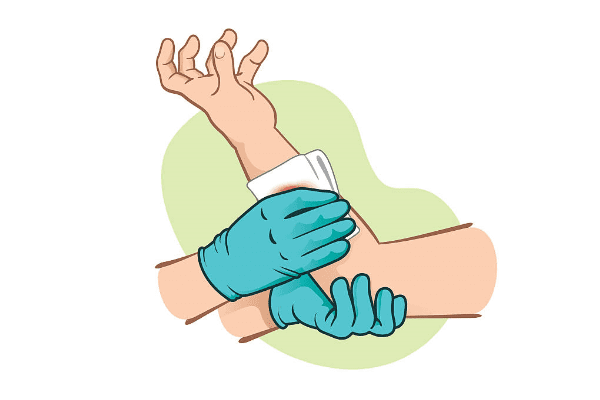Antiseptics and antibiotics >>>> Antiseptics for external use
Antiseptics for external use.

Antiseptics should not only have a high active effect against pathogenic microorganisms, but they should be harmless to those tissues that will be treated with an antiseptic, not have a toxic and destructive effect on the tissues of the organism itself. For these reasons, antiseptics are divided into antiseptics for external use and antiseptics for internal use.
External antiseptics are used for potentially possible bacterial, viral, fungal infections for the treatment of wound surfaces for trauma, for surgical wounds, for the treatment of trophic ulcers, for the prevention of wound infection before surgery, for purulent-inflammatory skin diseases.
The mechanism of action of external antiseptics.
Antiseptics for external use differ in the mechanism of action on pathogenic and conditionally pathogenic microorganisms :
- Acids, alkalis (solutions) change the concentration of hydrogen ions and thereby change the acidity of the bacteria habitat,
- Chemicals containing cytoplasmic poisons fold bacterial proteins,
- Halides denature protoplasmic proteins of pathogenic microorganisms,
- Dyes selectively inhibit the growth of bacteria depending on which bacteria are capable of staining with the selected aniline dye,
- Plant alkaloids inhibit the growth and reproduction of microorganisms,
- Unstable compounds – oxidizers that emit active oxygen, have a particularly toxic effect on some types of bacteria,
- A number of metal-containing compounds (silver nitrate, protargol, collargol, zinc sulfate, lead plaster, pentavalent antimony, arsenic compounds, mercury bichloride, chromium mercury and others) cause coagulation of proteins of microorganisms,
- Phenols and aldehydes act on microorganisms, fixing and preventing them from spreading, denaturing proteins,
- Hypertonic solutions have a weak antiseptic effect,
- Alcohols have a tanning effect, cause denaturation of protein structures of microorganisms and dehydration of their habitat,
- Detergents (soaps and other surface-active compounds of surfactants) have high antimicrobial activity, destroying the permeability and surface tension of the membrane of the microorganism. Subdivided into anionic surfactants and cationic surfactants.
- Proteolytic enzymes are used as antiseptics to dissolve necrotic plaque and accelerate regeneration processes.
The use of external antiseptics.
Halides and their solutions are used for the prevention, treatment and treatment of wounds of traumatic or surgical origin, disinfection of hands, premises and non-metallic objects. These include: Chloramine B, Iodinol, Iodopyridone, Iodoform, an alcohol solution of iodine and other derivatives of iodine and chlorine.
Aniline dyes are used for antiseptic treatment of burn surfaces, abrasions, pustular diseases of the skin and subcutaneous tissue, shallow wounds, and treatment of surfaces adjacent to the wound. These include: Brilliant Green, Methylene Blue, Ethacridine Lactate.
Oxidants are used for cleaning, washing wounds and abrasions, burns and ulcers. These include: hydrogen peroxide solution (3-6%), Hydroperite, Potassium permanganate.
Nitrofurans (furacilin, Furagin, Furazolin, Nifutsin) are used to wash purulent wounds, wound surfaces, cavities and as rinses for the skin and mucous membranes in infectious diseases.
Solutions, pastes and powders of acids and alkalis are used as keratolytic agents for skin diseases and treatment of wound surfaces. These include: Boric acid, Salicylic acid, Benzoic acid, Sodium tetraborate, Ammonium (ammonia solution - used to disinfect hands and objects).
Aldehydes are used to disinfect hands, objects, instruments and devices for medical purposes, premises. To do this, use: Formaldehyde solution (36-37%), Lizoform, Sidex, Hexamethylenetetramine. Urotropin is used as a drying and disinfectant for excessive sweating and acts on bacteria that cause diseases of the urinary tract.
Alcohols are used for antiseptics of wound surfaces, surgical and injection fields, disinfection of hands and instruments. For these purposes, alcohol solutions (70-95%) are used.
Hypertonic solutions are used to wash wounds with purulent and / or necrotic plaque. 10% sodium chloride solution, 30% urea solution and 40% glucose solution are used as antiseptics.
Phenols are used for antiseptics and treatment of skin diseases in the form of ointments, liniment or for lotions. A solution of phenol, carbolic acid (3-5%) is used for disinfection of premises, linen, objects, as well as for cauterization of the skin and mucous membranes. Resorcinol in the form of solutions is used as an antifungal and antibacterial agent for the skin and mucous membranes. For the treatment of skin diseases, Ichthyol, Birch tar, Naftalan oil are used.
Compounds of heavy metals are used as solutions for washing purulent wounds, cauterizing granulations (Silver nitrate, aka Lapis). For antiseptics of the upper respiratory tract, bladder, vagina, in the form of eye drops, zinc sulfate is used in different concentrations of solutions (for the eyes - 0.1-0.6%), Protargol, Collargol, Mercury oxycyanide. Xeroform (bismuth compound) is used as a weak astringent and antiseptic in the form of liniment and ointments. Lead plaster is used in cases of purulent - inflammatory skin diseases (carbuncles, furuncles).
Detergents (cationic soaps) are used to prepare the operating field, treat wounds, disinfect hands and household items of the patient. For these purposes, Chlorhexidine, Green soap, Cetylpyridinium chloride, Miramistin, Degmicid, Zerigel, Rokkal, Tergitsid are used. Cationic detergents are not combined with anionic soaps, as the antiseptic effect decreases.
Combined external antiseptics:
Boric alcohol - contains ethyl alcohol and boric acid. Applied in the form of ear drops for otitis media (unsafe), lotions and rubbing around the foci of pyoderma or affected areas with other purulent - inflammatory skin diseases.
Teimurova paste - contains boric acid, salicylic acid, zinc oxide, formalin, talc, lead acetate, glycerin. Used as an antiseptic drying agent for increased sweating , diaper rash.
Lassar paste - contains salicylic acid, zinc oxide, starch, petroleum jelly. It is used as a keratolytic, drying, antiseptic agent for skin diseases, pyoderma, bedsores, purulent skin diseases.

Read

Read


























